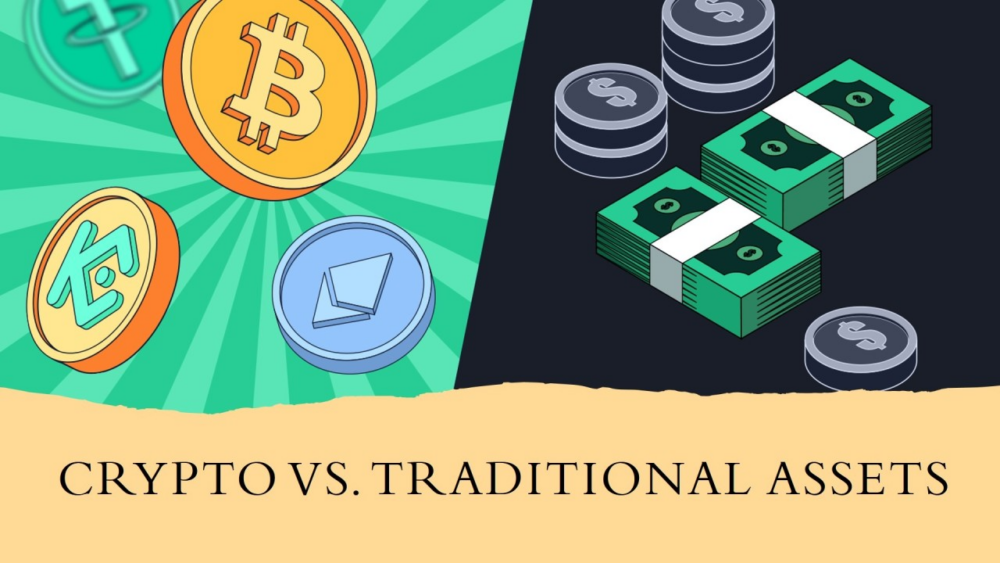
As the global financial landscape evolves, investors face a pivotal question: Should I invest in cryptocurrencies or stick with traditional assets? This article dives deep into the long-term profitability, risk, volatility, and future potential of both asset classes to help you make an informed decision.
Looking to get started with forex trading? AvaTrade offers a secure and regulated platform for trading major currency pairs, commodities, and more. Whether you’re a beginner or an experienced trader, AvaTrade provides powerful tools, educational resources, and real-time analytics to help you make smarter trading decisions. Explore forex trading opportunities with AvaTrade today.
1. Understanding the Basics
Cryptocurrencies
Cryptocurrencies are digital or virtual currencies that use cryptography for security. Bitcoin, Ethereum, and newer players like Solana or Avalanche operate on decentralized blockchain networks. These assets are typically not backed by any government or physical commodity.
Notably, in early April 2025, Bitcoin experienced a sharp decline, briefly falling below $75,000 due to rising global trade tensions, highlighting its vulnerability to macroeconomic shocks.
Traditional Assets
Traditional assets include stocks, bonds, real estate, commodities (like gold and oil), and cash equivalents. These are backed by tangible value or government regulation and have been the cornerstone of wealth generation for centuries.
2. Performance Comparison Over Time
Cryptocurrencies: High Risk, High Reward
- Bitcoin (BTC), the first and most well-known cryptocurrency, has returned over 15,000% since 2011.
- Ethereum (ETH) and others have also seen exponential growth, especially during bull cycles (e.g., 2017, 2021).
- However, crypto markets experience extreme volatility, with price swings of 20–30% in a single day not uncommon.
Interestingly, recent data shows that Bitcoin’s long-standing correlation with tech stocks (like the Nasdaq 100) may be weakening — suggesting it could soon behave more like an independent asset class.
Traditional Assets: Steady and Predictable
- Stock Market: The S&P 500 index has historically returned an average of 7–10% per year after inflation.
- Real Estate: Provides stable appreciation (3–5% annually) plus rental income.
- Gold: Long seen as a hedge against inflation, though it provides limited growth compared to equities.
3. Risk and Volatility
Cryptocurrencies
- Volatility: Extreme — prices can double or crash in weeks.
- Regulation: Lack of clear regulation creates uncertainty.
- Security: Subject to hacking and scams if not properly secured.
- Liquidity: High for top coins, but lower for small-cap assets.
Traditional Assets
- Volatility: Generally low to moderate.
- Regulation: Heavily regulated, offering investor protections.
- Security: Backed by laws, insurance (e.g., FDIC in the U.S.), and historical performance.
- Liquidity: Stocks and bonds are highly liquid; real estate less so.
4. Accessibility and Entry Barriers
Crypto
- Low entry barrier: Anyone with internet access can buy crypto.
- 24/7 markets.
- Easily fractionalized — you can invest as little as $10.
- Limited need for intermediaries.
Traditional Assets
- Stocks are accessible via brokerage accounts, but often require more setup.
- Real estate requires significant capital and legal processing.
- Markets are only open during business hours (except for some futures).
5. Diversification and Portfolio Role
Experts often recommend a balanced approach:
- Cryptocurrencies can act as high-growth speculative investments.
- Traditional assets provide stability, income, and risk management.
Suggested Portfolio Allocation (Based on Risk Tolerance):
| Risk Profile | Crypto | Stocks | Bonds | Real Estate |
| Conservative | 0–5% | 40% | 50% | 5–10% |
| Balanced | 5–15% | 50% | 30% | 5–10% |
| Aggressive | 15–30% | 60% | 5–10% | 10–15% |
6. Long-Term Outlook: What Experts Predict
Cryptocurrencies
- Potential for exponential growth with broader adoption (Web3, DeFi, digital ID).
- Risks include stricter regulations, tech vulnerabilities, or loss of investor interest.
- As seen in recent months, market sentiment remains highly sensitive to geopolitical and economic events. (Source)
Traditional Assets
- Expected to remain stable and continue moderate growth.
- Emerging markets and green energy may provide new opportunities.
7. Conclusion: Which One Is More Profitable in the Long Run?
There’s no one-size-fits-all answer. It depends on your:
- Risk tolerance
- Investment timeline
- Financial goals
In Summary:
- Cryptocurrencies offer high upside but come with significant risk and volatility.
- Traditional assets are reliable wealth builders with lower risk.
Final Thought:
A diversified portfolio — combining the innovation of crypto with the stability of traditional investments — may offer the best path toward long-term financial success.



